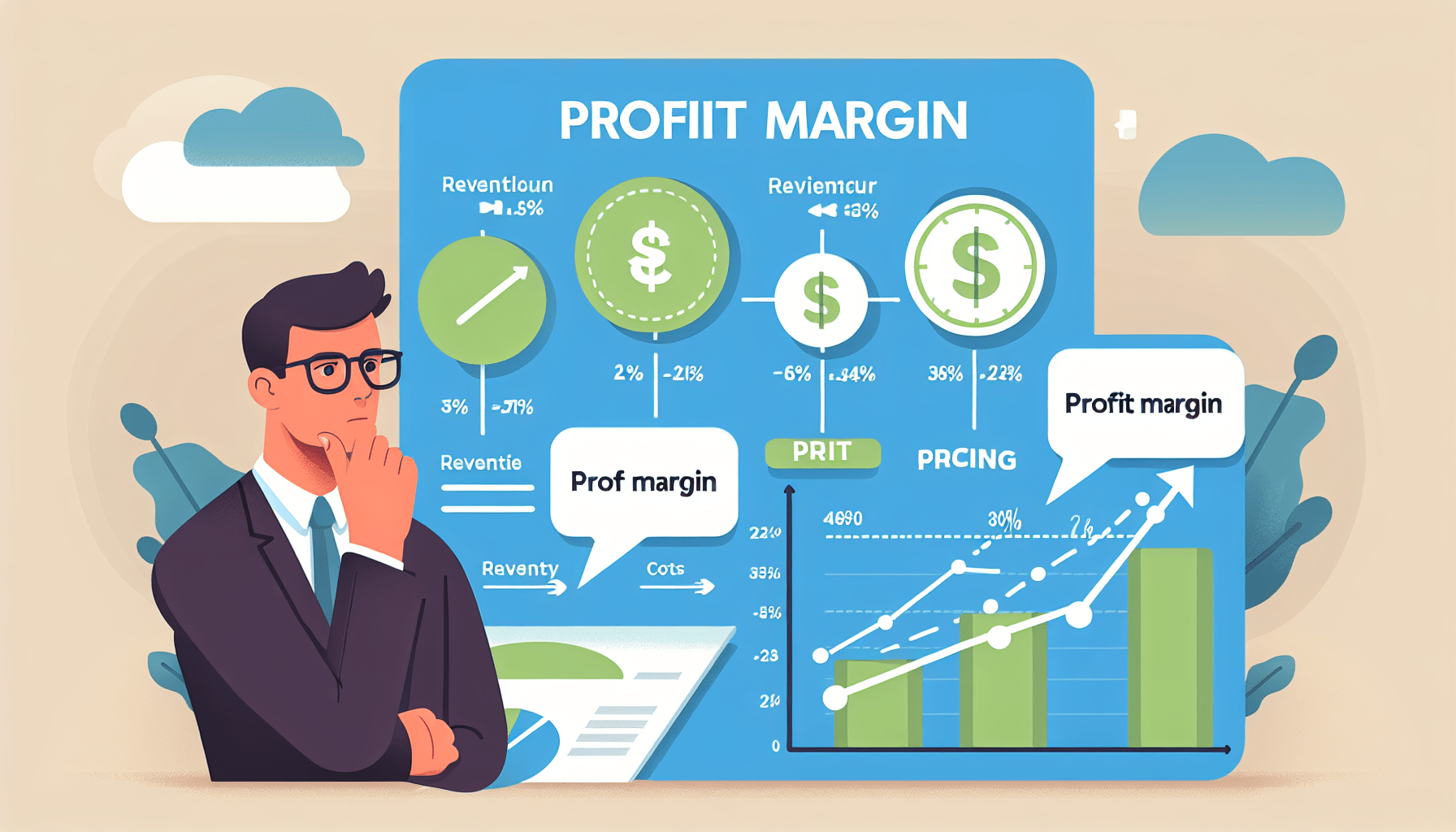What Is A Good Profit Margin For A Small Business?
Running a small business can be both challenging and rewarding, but one key factor that can significantly contribute to its success is the profit margin. However, determining what constitutes as a good profit margin for a small business can be a perplexing task. In the competitive marketplace, understanding the ideal profit margin that aligns with your industry and business type is crucial. This article aims to shed light on the concept of profit margin and provide valuable insights into what can be considered a good profit margin for a small business.
Factors to Consider
Industry
When determining what constitutes a good profit margin for your small business, it is important to consider the industry in which your business operates. Profit margins can vary significantly from one industry to another, due to factors such as the level of competition, pricing dynamics, and the cost structure specific to each industry. For example, industries with high competition and low barriers to entry may have lower profit margins, while industries with limited competition or high barriers to entry may have higher profit margins.
Size of Business
The size of your business can also influence what is considered a good profit margin. Generally, smaller businesses may have lower profit margins compared to larger businesses. This is because larger businesses often benefit from economies of scale and have the ability to spread their fixed costs over a larger revenue base. However, it is important to remember that the size of your business is not the sole determinant of a good profit margin, as other factors such as industry and expenses should also be taken into account.
Revenue
Another factor to consider when evaluating your profit margin is your business’s revenue. Revenue is a key driver of profit, as it represents the amount of money your business generates through sales. A higher revenue generally allows for a higher profit margin, as it provides a larger base to cover your expenses and generate profit. However, it is important to analyze your profit margin as a percentage of revenue, rather than just focusing on the absolute dollar amount, as this will allow for a more meaningful comparison across different businesses.
Expenses
In addition to revenue, it is crucial to consider your business’s expenses when determining what constitutes a good profit margin. Expenses can include costs such as materials, labor, rent, utilities, and marketing expenses. It is important to carefully manage and control your expenses in order to achieve a desirable profit margin. By reducing unnecessary costs and optimizing your business processes, you can improve your overall profitability and achieve a higher profit margin.
Benchmarking
Researching Industry Standards
Benchmarking is the process of comparing your business’s performance against industry standards. This can provide valuable insights into what is considered a good profit margin within your specific industry. By researching industry standards, you can gain a better understanding of the competitive landscape and identify areas for improvement. There are numerous resources available, such as industry publications, trade associations, and market research reports, that can provide data and benchmarks for your particular industry.
Comparing with Competitors
Another effective way to benchmark your business’s profit margin is to compare it with your competitors. This can provide a valuable benchmark and help you identify areas where your business may be underperforming or outperforming its competitors. By analyzing the profit margins of your competitors, you can gain insights into their cost structures, pricing strategies, and overall financial performance. This information can be used to make informed decisions and take necessary actions to improve your profit margin and maintain a competitive advantage.
Analyzing Historical Data
Analyzing your own historical data is another important aspect of benchmarking. By examining past profit margins, you can identify trends and patterns in your business’s financial performance. This analysis can help you understand the factors that have influenced your profit margin in the past and guide your decision-making process moving forward. Additionally, historical data can provide a baseline for comparison and help you set realistic profit goals for the future.

Importance of Profit Margin
Financial Stability
One of the key reasons why profit margin is important for a small business is because it directly impacts its financial stability. A healthy profit margin ensures that your business is generating enough revenue to cover its costs and sustain its operations. Without a sufficient profit margin, your business may struggle to meet its financial obligations, such as paying employees, suppliers, and creditors. A strong profit margin provides a solid financial foundation for your business and allows you to weather any unexpected challenges or downturns in the market.
Growth Potential
Profit margin also plays a crucial role in determining a small business’s growth potential. A higher profit margin means that your business is generating more profit from each dollar of revenue. This increased profitability provides the necessary funds to invest in growth initiatives, such as expanding your product line, entering new markets, or investing in marketing and sales efforts. By maintaining a good profit margin, you can fuel the growth of your business and position it for long-term success.
Attracting Investors
Investors and lenders often consider a company’s profit margin when evaluating its financial health and investment potential. A good profit margin indicates that your business is generating consistent profits and effectively managing its expenses. This can instill confidence in potential investors and lenders, making it easier for you to secure financing or attract equity investment. A strong profit margin can also enhance your business’s valuation, as investors are likely to place a higher value on a company that consistently generates high levels of profitability.
Determining a Good Profit Margin
Identifying Profit Goals
Before determining what constitutes a good profit margin for your small business, it is important to first identify your profit goals. This involves setting specific financial targets that align with your business objectives and growth aspirations. Profit goals are typically driven by factors such as desired return on investment, reinvestment needs, and industry norms. By clearly defining your profit goals, you can establish a benchmark against which you can evaluate your business’s profit margin and make informed decisions to achieve those goals.
Calculating Margins for Various Business Metrics
To determine a good profit margin, it is important to calculate margins for various business metrics. This includes metrics such as gross profit margin, operating profit margin, and net profit margin. Each of these metrics provides different insights into your business’s financial performance. For example, gross profit margin measures the profitability of your products or services before taking into account other expenses, while net profit margin reflects the overall profitability of your business after all expenses have been deducted. By calculating these margins and comparing them to industry standards and your profit goals, you can gain a comprehensive understanding of your business’s profit performance.
Considering Market Conditions
Market conditions can heavily influence what constitutes a good profit margin for your small business. Factors such as industry growth rates, customer demand, and pricing dynamics can impact the overall profitability of a business. For example, during periods of high demand and limited competition, businesses may be able to command higher prices and achieve higher profit margins. On the other hand, during economic downturns or periods of intense competition, profit margins may be squeezed. Therefore, it is important to consider the prevailing market conditions and adjust your profit margin expectations accordingly.

Profit Margin Examples
Retail Industry
In the retail industry, profit margins can vary widely depending on factors such as the type of retail operation, pricing strategy, and operating costs. For example, grocery stores typically have low profit margins due to intense competition and thin profit margins on staple goods. On the other hand, luxury retailers may have higher profit margins due to higher markups on exclusive products. It is important for retail businesses to carefully manage their costs, implement effective pricing strategies, and differentiate themselves from competitors in order to achieve and maintain a good profit margin.
Service-Based Business
Profit margins in service-based businesses can also vary depending on the nature of the services provided and the industry in which the business operates. For example, professional service firms such as law firms or consulting firms may have higher profit margins as they typically have lower operating costs and charge higher hourly rates for their services. On the other hand, service-based businesses that rely on high volumes and lower prices, such as cleaning services or catering businesses, may have lower profit margins. It is important for service-based businesses to accurately price their services, control their costs, and continuously improve their operational efficiency in order to achieve a good profit margin.
Manufacturing Sector
In the manufacturing sector, profit margins can be influenced by factors such as economies of scale, production efficiencies, and raw material costs. High-volume manufacturers that benefit from economies of scale and efficient production processes may have higher profit margins. On the other hand, manufacturers that rely on customized or low-volume production may have lower profit margins due to higher costs and lower production efficiencies. It is important for manufacturing businesses to optimize their production processes, negotiate favorable raw material costs, and continuously innovate in order to achieve and maintain a good profit margin.
Improving Profit Margins
Increasing Revenue
One way to improve your business’s profit margin is by increasing your revenue. There are several strategies that you can employ to achieve this, such as increasing prices, expanding your customer base, introducing new products or services, or enhancing your marketing and sales efforts. By generating more revenue, you can spread your fixed costs over a larger revenue base, which can lead to higher profit margins. It is important to carefully analyze your pricing strategy, market demand, and competitive landscape when implementing revenue growth initiatives to ensure that they are sustainable and aligned with your profit goals.
Reducing Costs
Reducing costs is another effective way to improve your business’s profit margin. By identifying and eliminating unnecessary expenses, negotiating favorable terms with suppliers and vendors, and improving operational efficiencies, you can lower your overall cost structure and increase your profitability. It is important to regularly review your expenses and identify areas where cost savings can be achieved without compromising the quality of your products or services. By continuously seeking cost reduction opportunities, you can enhance your profit margins and strengthen your business’s financial performance.
Optimizing Pricing Strategies
Optimizing your pricing strategies can also have a significant impact on your profit margins. By accurately pricing your products or services to reflect their value and market demand, you can maximize your revenue and profitability. This involves conducting thorough market research, analyzing customer behavior and preferences, and monitoring your competition. By understanding the price sensitivity of your customers and adapting your pricing strategies accordingly, you can achieve a balance between attracting customers and maximizing your profit margins. Regularly reviewing and adjusting your pricing strategies based on market conditions and customer feedback is crucial to maintaining a good profit margin.
Potential Challenges
Economic factors
One of the potential challenges that small businesses face when striving to achieve a good profit margin is economic factors such as inflation, interest rates, and changes in consumer spending habits. These external factors can impact the overall profitability of a business by increasing costs, affecting customer demand, and influencing pricing dynamics. It is important for small business owners to closely monitor economic conditions and adjust their business strategies accordingly. By proactively managing the impact of economic factors, businesses can mitigate risks and maintain a stable profit margin.
Competitive pressures
Competitive pressures can also pose challenges for small businesses in achieving a good profit margin. Intense competition within an industry can lead to price wars, necessitating businesses to lower their prices and reduce their profit margins in order to attract customers. Additionally, new entrants or disruptive business models can further intensify competition and erode profit margins. It is important for small business owners to differentiate their products or services, identify unique value propositions, and continuously innovate in order to remain competitive and maintain a good profit margin.
Seasonal variations
Seasonal variations can also impact the profit margins of many small businesses. Certain industries, such as retail, hospitality, and tourism, experience fluctuations in customer demand depending on the time of year. For example, a restaurant located in a tourist destination may have higher profit margins during the peak tourist season compared to the off-peak season. It is important for businesses to anticipate and plan for these seasonal variations by adjusting their cost structures, pricing strategies, and marketing efforts. By effectively managing seasonal fluctuations, businesses can maintain a stable profit margin throughout the year.
Common Mistakes to Avoid
Setting Unrealistic Goals
One common mistake that small business owners make is setting unrealistic profit goals. While it is important to have ambitious targets, setting goals that are too high can create unnecessary pressure and set your business up for failure. It is important to conduct a thorough analysis of your business’s financials, industry standards, and market conditions in order to set realistic and achievable profit goals. By setting attainable goals, you can maintain motivation, track your progress, and make adjustments as necessary to improve your profit margin.
Underestimating Costs
Another common mistake is underestimating costs. It is essential to accurately estimate all expenses associated with running your business, including both direct costs and indirect costs. Failure to account for all costs can lead to lower profit margins and financial instability. Additionally, small business owners should regularly review and reevaluate their expenses to identify opportunities for cost reduction and efficiency improvement. By carefully managing your costs, you can optimize your profit margin and ensure the financial health of your business.
Neglecting Continuous Evaluation
Continuous evaluation of your profit margin is crucial for maintaining and improving profitability. Neglecting to regularly monitor and analyze your financial performance can lead to missed opportunities or the persistence of inefficiencies that can erode your profit margin. It is important to establish a system for ongoing financial analysis, such as conducting regular cash flow statements, profit and loss reports, and balance sheet reviews. By consistently evaluating your profit margin and identifying areas for improvement, you can make informed business decisions and take proactive measures to enhance your profitability.
Monitoring and Adjusting Profit Margins
Regular Financial Analysis
Monitoring and analyzing your profit margins on a regular basis is essential for maintaining a healthy and sustainable business. Regular financial analysis allows you to track your progress, identify trends, and spot any areas of concern. By conducting regular cash flow analysis, profit and loss reviews, and balance sheet evaluations, you can gain insights into the financial health of your business and make data-driven decisions to improve your profit margins.
Identifying Areas for Improvement
Regular monitoring of your profit margin also enables you to identify specific areas for improvement. By analyzing your expenses, revenue streams, and pricing strategies, you can uncover inefficiencies or opportunities for optimization. For example, you may identify that certain costs can be reduced or eliminated, or that certain products or services have higher profit margins and should be prioritized. By continuously evaluating and adjusting your business processes, you can enhance your profit margins and drive overall profitability.
Making Informed Business Decisions
Monitoring and adjusting your profit margins empower you to make informed business decisions based on accurate and up-to-date financial information. By understanding the drivers of your profit margin, you can make strategic decisions regarding pricing, cost control, and growth initiatives. For example, if you notice that your profit margin is lower than industry benchmarks, you may need to adjust your pricing strategy or explore cost reduction opportunities. By leveraging financial analysis, you can make informed decisions that positively impact your profit margins and overall business performance.
Conclusion
Determining what constitutes a good profit margin for your small business involves considering factors such as industry dynamics, business size, revenue, and expenses. By benchmarking against industry standards and competitors, you can gain valuable insights into your business’s profit performance. A good profit margin is crucial for financial stability, growth potential, and attracting investors. By setting realistic profit goals, calculating margins for various business metrics, and considering market conditions, you can establish and achieve a good profit margin. Continuous evaluation, improvement initiatives, and informed decision-making are necessary to monitor and adjust profit margins. By following these guidelines, you can position your small business for long-term success and profitability.


